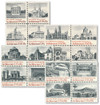
# 1779/2022 - Complete Set of 16 stamps, 1979-1982 American Architecture Series
Get the Complete American Architecture Series
Introduced in 1979, the American Architecture Series was created to honor the evolution of American architecture over the last two centuries. Each of the buildings was selected for its enduring beauty, strength, and usefulness. These stamps honor American creativity and ingenuity by picturing some of our most beautiful buildings. All of the stamps include the name of the architect, their birth and death years, and the name of the building. Save time and money by getting the complete set in one easy order.
More About the Stamps
The first stamps in the series were issued on June 4, 1979, in Kansas City, Missouri at the National Convention of American Institute of Architects. The buildings pictured on these stamps are generally from the period of Classic Revival of the Post-Colonial Period to the Greek Revival, which lasted until about 1860.
Pictured are the William Strickland’s Philadelphia Exchange, Charles Bulfinch’s Boston State House, Benjamin Henry Latrobe’s Baltimore Cathedral, and the Rotunda of the University of Virginia, which was designed by Thomas Jefferson.
The second block of four stamps was issued on October 9, 1980, at the convention of the National Trust for Historical Preservation in New York, New York. The buildings honored in this block were constructed during the 19th century, an era of Gothic Revival, when buildings took inspiration from the Middle Ages as well as Victorian architecture.
The stamps illustrate the Smithsonian Institution (James Renwick), the Trinity Church (Henry Richardson), the Pennsylvania Academy of Fine Arts (Frank Furness), and the Lyndhurst (Alexander J. Davis). According to the USPS, the buildings featured were selected because of their “enduring beauty, strength and usefulness.”
The third block in the series was issued on August 28, 1981 at the National Building Museum in Washington, DC. The buildings in this group date from the late 1800s to the early 1900s, a period when architects stopped sticking to particular styles and began exploring new directions. The eclectic architecture of this era often took inspiration from any styles or buildings that came before it, and might even combine elements from multiple styles into one building.
The stamps show the New York University Library by Stanford White, the Biltmore House by Richard Morris Hunt, the Palace of the Arts by Bernard Maybeck and the National Farmer’s Bank by Louis Sullivan.
The final four stamps in the series were issued on September 30, 1982, at the headquarters of the American Institute of Architects in Washington, DC. The stamps’ issue coincided with the 125th anniversary of that organization. These stamps all pictured modern architecture.
The stamps in the final issue picture Frank Lloyd Wright’s Fallingwater, Mies van der Rohe’s Illinois Institute of Technology, the Gropius House, by Walter Gropius, and Eero Saarinen’s Dulles Airport.
Get the Complete American Architecture Series
Introduced in 1979, the American Architecture Series was created to honor the evolution of American architecture over the last two centuries. Each of the buildings was selected for its enduring beauty, strength, and usefulness. These stamps honor American creativity and ingenuity by picturing some of our most beautiful buildings. All of the stamps include the name of the architect, their birth and death years, and the name of the building. Save time and money by getting the complete set in one easy order.
More About the Stamps
The first stamps in the series were issued on June 4, 1979, in Kansas City, Missouri at the National Convention of American Institute of Architects. The buildings pictured on these stamps are generally from the period of Classic Revival of the Post-Colonial Period to the Greek Revival, which lasted until about 1860.
Pictured are the William Strickland’s Philadelphia Exchange, Charles Bulfinch’s Boston State House, Benjamin Henry Latrobe’s Baltimore Cathedral, and the Rotunda of the University of Virginia, which was designed by Thomas Jefferson.
The second block of four stamps was issued on October 9, 1980, at the convention of the National Trust for Historical Preservation in New York, New York. The buildings honored in this block were constructed during the 19th century, an era of Gothic Revival, when buildings took inspiration from the Middle Ages as well as Victorian architecture.
The stamps illustrate the Smithsonian Institution (James Renwick), the Trinity Church (Henry Richardson), the Pennsylvania Academy of Fine Arts (Frank Furness), and the Lyndhurst (Alexander J. Davis). According to the USPS, the buildings featured were selected because of their “enduring beauty, strength and usefulness.”
The third block in the series was issued on August 28, 1981 at the National Building Museum in Washington, DC. The buildings in this group date from the late 1800s to the early 1900s, a period when architects stopped sticking to particular styles and began exploring new directions. The eclectic architecture of this era often took inspiration from any styles or buildings that came before it, and might even combine elements from multiple styles into one building.
The stamps show the New York University Library by Stanford White, the Biltmore House by Richard Morris Hunt, the Palace of the Arts by Bernard Maybeck and the National Farmer’s Bank by Louis Sullivan.
The final four stamps in the series were issued on September 30, 1982, at the headquarters of the American Institute of Architects in Washington, DC. The stamps’ issue coincided with the 125th anniversary of that organization. These stamps all pictured modern architecture.
The stamps in the final issue picture Frank Lloyd Wright’s Fallingwater, Mies van der Rohe’s Illinois Institute of Technology, the Gropius House, by Walter Gropius, and Eero Saarinen’s Dulles Airport.






